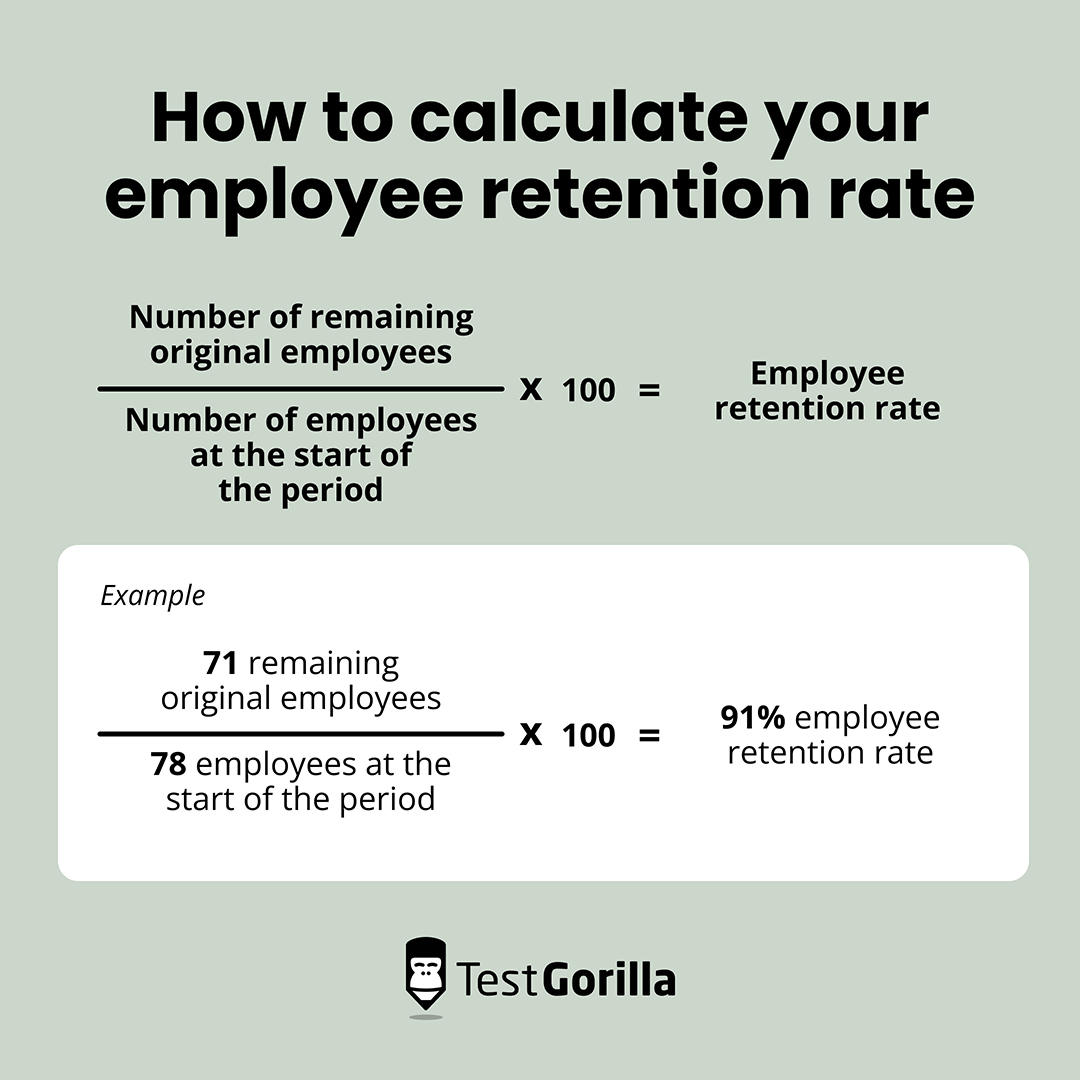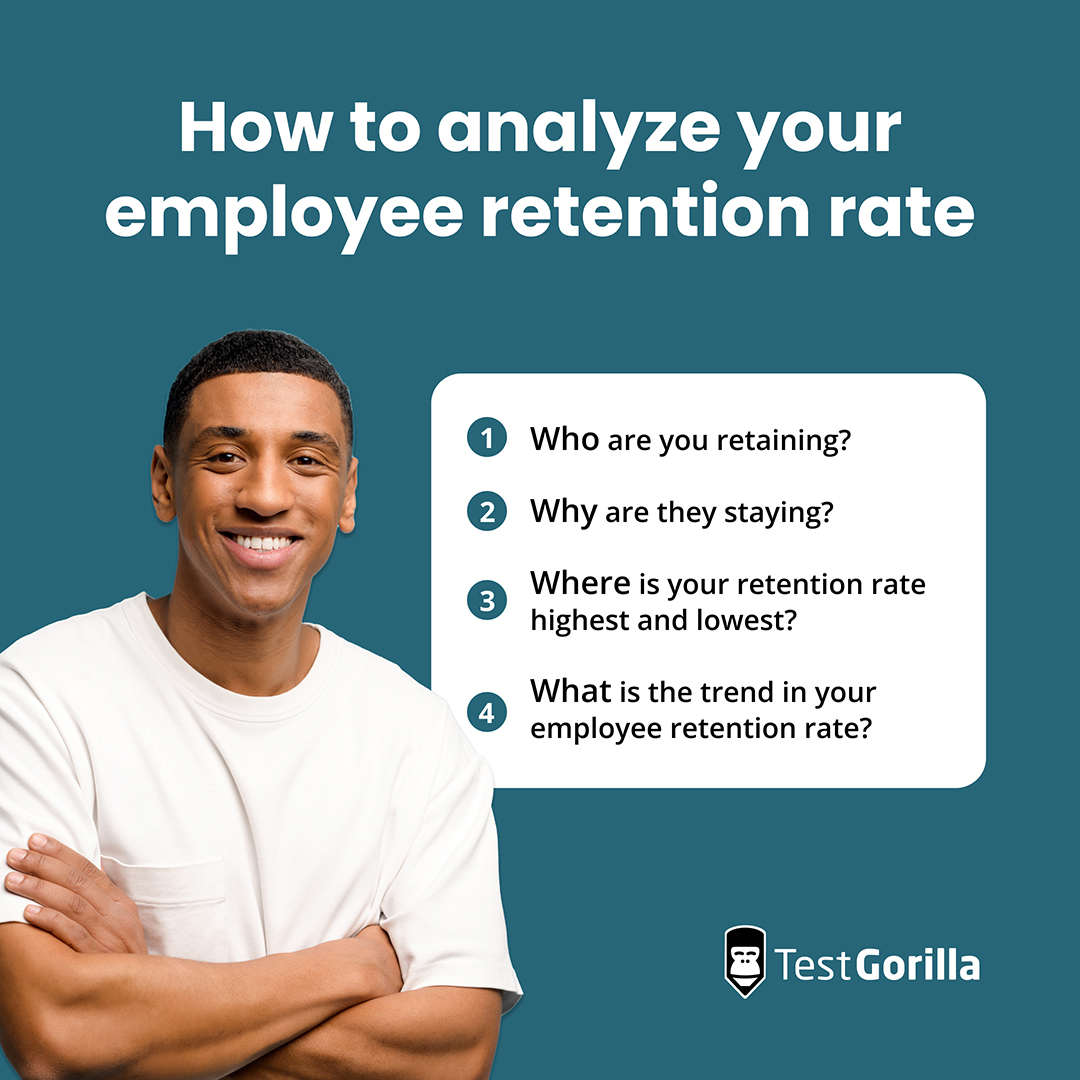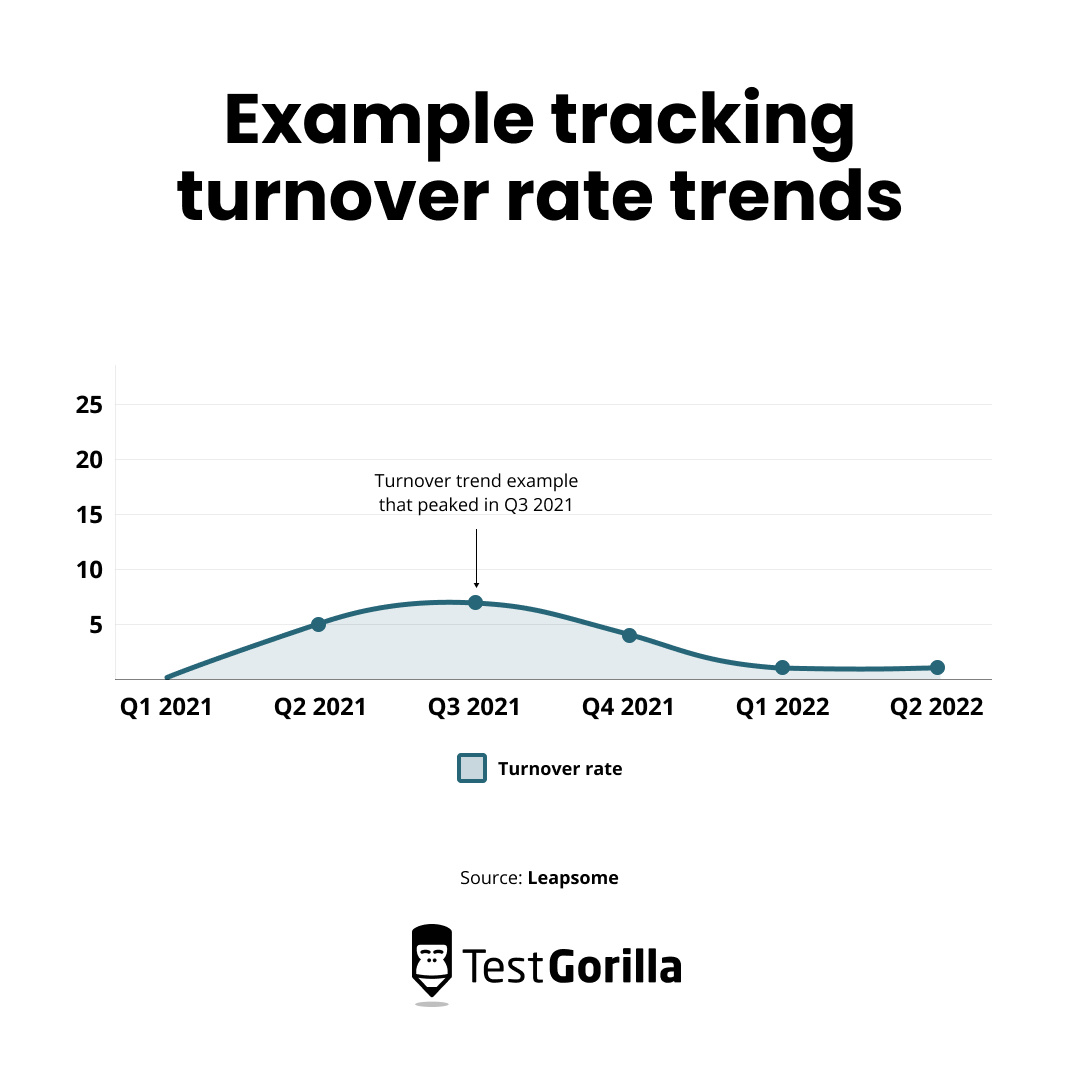How to calculate and improve your employee retention rate
It pays to prioritize employee retention. Replacing an employee can cost anywhere from half to two times that employee’s salary – and that’s just a conservative estimate.[1]
Don’t wait until you notice a spike in resignations to act.
One-off incentives like retention bonuses can help you slow a downward spiral, but they aren’t enough to fix a falling retention rate by themselves.
You need a solid strategy for keeping employees motivated and fulfilled throughout their tenure with you.But which employee retention strategies have the greatest effect on your overall staff retention rate?
In this article, we show you how to calculate your employee retention rate and how to increase your employee retention rate with 37 proven tactics.
Table of contents
What is employee retention rate?
Employee retention rate measures the percentage of employees who remain in their roles over a given period.
A high retention rate is good because it shows that employees are happy in their roles and suggests that they are unlikely to leave. A low retention rate, on the other hand, suggests issues with the employee experience in your organization.
When you calculate employee retention rate, you gain insight into many aspects of your business, including:
Quality of hires
Upcoming hiring needs
Management
Employee morale
Job satisfaction
Company culture
Workplace environment
Future performance
Employee retention rate vs. employee turnover rate
The other side of employee retention is, of course, employee loss. There are a few ways to track this.
The first one is your employee turnover rate.
Your employee turnover rate tracks the percentage of employees who leave your company, whether that be voluntary turnover or involuntary turnover. Specifically, it refers to employees whose roles you intend to fill after they leave.
Employee retention rate vs. employee attrition rate
Employee attrition rate, on the other hand, tracks the percentage of employees who leave whose roles you do not intend to fill immediately. This covers many scenarios in which you’re willingly trying to reduce your total number of employees, such as redundancy or obsolescence.
Why should you calculate your employee retention rate?
Calculating your employee retention rate is important because it helps you gauge the current success of your HR initiatives.
Analyzing your employee retention rate can also help you make decisions about which employee retention trends to try in your workforce and track their success.
This is essential because turnover costs can be hefty, losing you time and money through:
Employee productivity loss
Recruitment marketing
Hiring technology costs
Screening and interviewing candidates
Salaries and sign-on bonuses for new employees
One study suggests retaining a salesperson for three years instead of two makes a difference of $1.3M in net value to the organization over three years.[2]
How to calculate employee retention rate
The employee retention rate formula is as follows:
Employee retention rate = (Number of remaining original employees / Number of employees at the start of the period) 𝗑 100
There are employee retention rate calculators online, or you can calculate it manually using the following steps:
1. Decide the period to examine
You can use any set period of time to calculate employee retention rate. However, it’s usually best to look at longer time frames to understand how long employees stay with your company.
You should incorporate employee retention rate into your regular HR reporting for multiple given time periods, such as calculating your staff retention rate monthly, quarterly, and annually.
2. Gather starting data
Identify the number of employees working on the first day of your chosen period.
If you’re calculating the employee retention rate for one calendar year, do a headcount of the number of employees on the payroll on January 1. Do not count anyone who joins the company after that date, even if they’re filling the role of your lost employees.
3. Count remaining employees
Count the number of the original employees who are still on the payroll at the end of the chosen period.
For instance, let’s say you have 78 employees on January 1 and 71 remain on December 31.
4. Calculate retention rate
To calculate the employee retention rate, divide the number of remaining employees (71) by the number of starting employees (78.) Then, multiply the result by 100 to get the employee retention rate as a percentage.
In this example, your calculations would be:
71 ÷ 78 = 0.91
0.91 x 100 = 91
That makes the employee retention rate 91%.
How to calculate employee retention rate: Examples
Below are two more examples of how to calculate employee retention rates.
Example 1
You started the last tax year with 134 employees on your payroll. By the end of the tax year, 27 were gone, leaving you with 107 of your original employees remaining. In that time, you hired 30 new recruits.
In this example, the employee retention rate formula is (107 ÷ 134) x 100. This makes the retention rate 79.8%.
The 30 new employees aren’t relevant to the employee retention rate calculation.
Example 2
Your company has two locations, and you want to compare their retention rates over two years.
Location A began this period with 39 employees. In the end, 33 original employees remained.
Location B started with 25 employees; 19 remained after two years.
The employee retention rate calculation for Location A is (31 ÷ 39) x 100, yielding a retention rate of 79.4%.
Location B’s calculation is (19 ÷ 25) x 100, giving you a retention rate of 76%.
Location A retained a higher proportion of its employees than its counterpart. You can now perform an analysis of why its employees are more likely to stay, looking at its:
Operations
Working environment
Management practices
What is a good employee retention rate?
Employees leaving is a fact of life. You can’t and shouldn’t aim for a 100% retention rate forever. So, how do you know when fluctuations in retention indicate a problem?
Monitoring your employee retention rate over time is one way to understand what a healthy retention rate looks like for you. Unexplained or sustained reductions in retention could indicate issues. To do this, calculate the rate of the average number of employees lost year over year, then compare it to that of your current year.
It’s also important to contextualize alongside your location and industry average retention rates. Employers in the US can consult the US Bureau of Labor Statistics. You can also find specific reports from companies such as Workhuman.
For example, one survey found that the average employee retention rate among US businesses from 2022 to 2023 was 82.7%.[3]
The same survey examined the average employee retention rate by industry. The retail and wholesale industry had the lowest average employee retention rate at 67.1%; the chemicals and energy sectors had the highest employee retention rates at more than 87%.
You should also contextualize staff member retention statistics by position. Some functions have good retention rates, such as:
Executives (94.9%)
Information Technology (93.5%)
Sales, Marketing, and Product Management (90%)
By contrast, the HR function has a lower average employee retention rate at circa 85%.[4]
How to analyze your employee retention rate
Once you have calculated your overall employee retention rate, you now need to analyze it to make decisions.
To do that, you must consider four questions.
Who are you retaining?
Where are retention rates at their highest? Look at various factors, such as:
Location
Department
Function
Compensation band
You might even analyze your workforce by their mode of working. One study by Remote found that flexible and remote roles had higher retention rates compared to in-person jobs.[5]
Why are they staying?
Now you know who’s staying, try to find out what’s keeping them in their role, for instance, a great manager or a cohesive team.
Take the flexible work example. Almost 40% of people who work flexibly feel a benefit for their mental health – this employee satisfaction could be why your flexible workers stick around.
Where is your retention rate highest and lowest?
Combine the insights from the first two steps to create a game plan for tackling high turnover.
One advanced industrial company found that the plants with the highest retention rates among frontline workers were the ones with high leadership scores. Sure enough, focus groups in low-retention plants revealed strained relations between managers and peers.[6]
What is the trend in your employee retention rate?
Finally, examine how these trends have changed over time. For example, a spike in turnover may coincide with a change in management and then a return to normal, suggesting a one-off incident.
You can even use HR tools like Leapsome to project past trends forward into the future, such as predicting overall turnover (and therefore retention) rates:
How to improve your retention rate: 37 tactics to implement
Now that you know how to measure employee retention rate and what a good staff retention rate looks like, you can start looking at tactics to improve yours.
Here are 37 ideas for how to increase employee retention rate at your company.
37 tactics to improve your employee retention rate: Summary table
Want the headlines so you can skip straight to the right tactic for you? Here’s a summary of our tips.
How to reduce your turnover rate: tips | Example actions |
Leadership and culture | |
1. Train leaders to clearly communicate your mission and values | If your company values a learning mindset, leaders should discuss how they learn new skills |
2. Be mindful of your corporate reputation | Announce purpose-driven decisions on social media |
3. Hire the right people using skills-based hiring | Use skills tests to find new hires with the right skill sets |
4. Build a culture of one-on-one meetings | Set guidelines for how often managers should have one-on-one meetings with team members |
5. Add a chief experience officer to your leadership team | The chief experience officer sets budgets and priorities for employee benefits |
Diversity and inclusion | |
6. Publicize your efforts to eliminate hiring bias and promote diversity in the workplace | Notify employees of the switch to skills-based hiring |
7. Offer all HR reps diversity training | Ensure all decision makers for promotion processes have diversity training |
8. Don’t neglect generational diversity | Use Culture Add tests to ensure generationally diverse teams mesh well together |
9. Build an inclusive workplace culture | Set up affinity groups for marginalized employees |
Listening to employees | |
10. Create a comprehensive plan for collecting employee feedback | Ensure you have a tool and process for collecting short-, medium-, and long-term feedback |
11. Use employee listening tools | Install an “always on” feedback tool to collect spontaneous feedback |
12. Set up mechanisms for upward feedback | Start a reverse mentoring program for leaders |
13. Conduct regular “stay interviews” with employees | Incorporate stay interviews into yearly review meetings |
Compensation and incentives | |
14. Create an airtight employee compensation policy | Create clear policies around raises, benefits, overtime, and other pay issues |
15. Set up employee recognition programs | Open peer-to-peer recognition channels as well as formal programs |
16. Use incentive programs to manage employee engagement | Offer spot and yearly bonuses for high performers |
Employee wellbeing and benefits | |
17. Create a comprehensive employee benefits plan | Offer extended parental leave for all workers |
18. Include specific provisions for employee mental health | Provide both crisis resources like mental health first aid and ongoing initiatives like mental health days |
19. Align employee wellbeing initiatives with your corporate purpose | If you’re committed to sustainability, offer employee wellbeing initiatives that benefit the environment, like clean commute incentives |
20. Test different types of flexible work | Offer flextime with a required daily or weekly number of hours |
21. Outline a strong remote work policy | Include stipulations as to how long employees can work from home or from abroad |
22. Ask leaders to role model work-life balance | Leaders should not respond to or send emails out of hours |
23. Use HR analytics to track the uptake of HR programs | Monitor which benefits employees use and add or remove benefits based on this data |
Internal mobility and career growth | |
24. Create a plan to boost internal mobility | Assemble an internal mobility task force to spot candidates for promotion |
25. Provide employees with professional development plans | Use insights from skills tests to design training plans |
26. Compile employee skill data in an internal talent marketplace | Log all new recruits’ skills test results in a database to consult when hiring internally |
27. Broadcast your investment in employees’ career growth | Send out a regular newsletter to remind employees of the career resources available |
28. Consider job rotation programs for entry-level employees | Rotate new recruits through different entry-level roles in the same department to introduce them to different functions |
Nurturing employees’ skills | |
29. Start addressing skills gaps during onboarding | Use insights from skills tests to tailor new employees’ early training |
30. Give employees a budget for training | Give each employee 3% of their salary to spend on training of their choice |
31. Use employee coaching to nurture future leaders | Assign coaches to junior employees who show leadership potential in skills tests |
32. Be proactive about upskilling employees | Give employees additional development opportunities for their digital skills |
33. Turn to reskilling before restructuring | Use reskilling programs to redeploy at-risk workers into essential roles |
Managing when employees leave | |
34. Begin offboarding at the point of hiring | Let employees know you understand they will probably leave one day during the onboarding process |
35. Use combined metrics to identify employee flight risks | Look out for low participation in skills programs as a sign of disengagement |
36. Institute phased retirement plans for older workers | Encourage older workers to “soft retire” into being part-time to help acclimate replacement |
37. Conduct exit surveys with all workers | Invite all leavers for exit surveys, even if you don’t expect them to return as boomerang employees in the future |
1. Train leaders to clearly communicate your mission and values
When employees identify with their company’s vision and values, they are:
More likely to recommend their employer (by 45%)
More likely to gain a sense of accomplishment from work (by 43%)
Less likely to consider leaving (by 11%)[7]
Encourage executives to use leadership communication and role model key values in their interactions with employees.
For instance, if your company values a learning mindset, leaders should discuss what actions they take to learn new skills in meetings with employees.
2. Be mindful of your corporate reputation
The next way to increase employee retention rate is by making this integrity part of your corporate reputation.
Your corporate reputation is the perception of your company among stakeholders, including:
Employees
Customers
Shareholders
Suppliers
Broadcast your value-driven decision-making so that employees feel proud to work for you and want their name attached to your brand.
3. Hire the right people using skills-based hiring
Prove your commitment to values like fairness and data-driven decision-making by using skills-based hiring tools like skills tests. This shows employees you are working to eliminate bias in your workplace, fostering a sense of loyalty.
Skills tests also enable you to directly observe candidates’ skills and hire the right people in the first place. This means they’re less likely to burn out or quit. In sum, skills-based hiring improves retention.
4. Build a culture of one-on-one meetings
It’s important to build trusting relationships between managers and the team members they’re responsible for, and the best way to do this is by building a culture of one-on-one meetings.
This tactic fosters connections between colleagues, which 75% of office workers say makes them more likely to stay in a role.
5. Add a chief experience officer to your leadership team
Hiring a chief experience officer shows employees you prioritize their wellbeing. It’s similar to the classic head of HR roles at many organizations but with a specific focus on employee experience.
The chief experience officer would allocate budgets for employee benefits, design strategies for improving employee retention, and advocate for other positive changes.
6. Publicize your efforts to eliminate hiring bias and promote diversity in the workplace
Diversity in the workplace is strongly linked with higher employee retention rates.
Research shows that increased levels of gender diversity and the presence of HR policies around diversity are linked to higher retention.[8]
Adopting skills-based hiring is the first step. Next, ensure your employees know about the policy and that it’s part of larger initiatives to boost diversity.
7. Offer all HR reps diversity training
To follow through on these diversity initiatives, you should also give all HR reps and hiring managers diversity training.
This limits bias in internal processes like promotion. Did you know that studies show women are less likely to be promoted than their male colleagues despite outperforming them and being less likely to quit?
8. Don’t neglect generational diversity
Team members of different ages bring diverse skills and perspectives to the table, which can improve innovation by as much as 20%.[9]
However, generational diversity can also cause friction if teams don’t share common ground.
Use Culture Add tests to ensure that all employees share the same values, and keep generational diversity at the front of your mind when designing inclusive initiatives.
9. Build an inclusive workplace culture
Companies with inclusive cultures are likely to have high retention rates. Team members who report feeling “very included” are nearly three times more likely to pursue career development with their employer than those who don’t.[10]
You can build an inclusive culture in many ways, for instance, by setting up affinity groups for marginalized employees.
10. Create a comprehensive plan for collecting employee feedback
Many organizations rely on a reactive approach to employee feedback, only asking for it when something’s gone wrong.
Creating a proactive plan for tackling employee feedback instead provides opportunities for:
Short-term, solicited feedback about a specific subject
Medium-term feedback, perhaps reflecting on the last quarter or the probation period of a new manager
Long-term feedback: yearly reflections on the organization and bigger-picture ideas for its improvement
Spontaneous feedback on any topic initiated by the employee
11. Use employee listening tools
Employee listening is the practice of collecting regular feedback to better understand your employees, for example, using “always-on” feedback tools where employees can log comments spontaneously.
Employee listening tools are helpful because they prevent employees’ gripes from festering into resentment and ensure good ideas are noted by management.
12. Set up mechanisms for upward feedback
Upward feedback refers to the opportunity for employees to express their opinions to management.
It shows employees that their opinions are valued and can stop leaders from losing touch with the average employee’s experience at their organization.
To implement upward feedback, try reverse mentoring: pairing senior executives with junior employees to hear their perspectives.
13. Conduct regular stay interviews with employees
We’ve all heard of exit interviews – and we discuss them below – but employers shouldn’t wait for employees to leave to find out about their employee experience.
Stay interviews are directly targeted at understanding why employees choose to stay with you and can give you insight into your employee retention rate. Combine them with salary or performance reviews to cover multiple bases at once.
14. Create an airtight employee compensation policy
Studies show that the biggest motivator for employees to stay with their employer is their salary and potential bonuses.
Employers must, therefore, prioritize creating a strong employee compensation policy.
This doesn’t just mean “offer more money.” Although competitive compensation is important, it’s crucial to have a clear policy around raises, bonuses, and commissions, all while balancing this with a well-rounded benefits package.
It’s also possible for an employee to quit while oblivious that their next raise is right around the corner. An employee is more likely to stick around when they know if and when their next raise is coming.
15. Set up employee recognition programs
Retention isn’t all about money. Interpersonal connection is also important, and fostering a culture of appreciation can also increase your employee retention rate.
Start by setting up an employee recognition program that offers multiple avenues for praise, such as a peer-to-peer shoutout channel in Slack and a company-wide employee of the month scheme.
16. Use incentive programs to manage employee engagement
Low employee engagement can be a sign an employee is unfulfilled and considering employment elsewhere.
Poorly engaged teams have 18% to 43% lower retention rates than engaged ones.
Employee incentive programs re-engage employees by promising perks in exchange for high performance. A balanced approach is best, for example, complementing recognition programs with spot and yearly bonuses.
17. Create a comprehensive employee benefits plan
Employee recognition and incentives are both related to individual or team performance. Employee benefits are perks that all employees receive and that provide a baseline level of comfort or value for workers.
Popular employee benefits include:
Comprehensive healthcare
Extended parental leave
Flexible working
18. Include specific provisions for employee mental health
Many employers provide physical healthcare, however, you should also include specific provisions to improve mental health in the workplace.
Don’t limit these to crisis resources like mental health first aiders or free counseling sessions. Include initiatives like mental health days and “summer hours” for employees to spend time outdoors in good weather.
19. Align employee wellbeing initiatives with your corporate purpose
Employee wellbeing initiatives are a powerful tool to demonstrate your priorities as an employer while also tailoring your benefits package to the needs and desires of your workforce.
An example is a company with sustainability commitments offering employee wellbeing initiatives that benefit the environment, like a cycle-to-work scheme.
20. Test different types of flexible work
Flexible working gives employees more control over their schedule, helping them make healthier lifestyle choices and manage challenging circumstances like long-term illness or caring responsibilities.
There are many ways to implement this:
A compressed work week – for example, four days
Employees choosing their own schedule
“Flextime” within certain parameters, such as a set number of required daily hours
21. Outline a strong remote work policy
Most flexible teams incorporate some measure of remote working. To keep a smooth-running team when employees work asynchronously, set out a remote work policy outlining:
What hours they should work
Where they can work – for instance, time limits on how long they can work from abroad
How they should communicate with their teams and managers
22. Ask leaders to role model work-life balance
To prove to your workforce that you care about employee work-life balance – and aren’t just saying it to sound good – ask your leaders to role-model ideal behavior of building separations between work and their personal lives.
Yvon Chouinard, the founder of Patagonia, did this.
He encouraged employees to use their flexible schedules to surf when the weather was good. He then role-modeled his commitment to work-life balance by taking months off each year to go fishing, instructing staff not to contact him in his time off.[11]
23. Use HR analytics to track the uptake of HR programs
One study suggests there is an 83% gap between the health and wellbeing benefits employees have and the ones they want.
To avoid wasting time and money on initiatives that don’t benefit your employee retention rate, use HR analytics to track which benefits your employees use. Use this data to inform – and, if necessary, reform – your benefits package.
24. Create a plan to boost internal mobility
If an employee is promoted within three years of hiring, they are 70% likely to stay with their employer. By contrast, those who don’t get promoted have only a 45% chance of staying long-term.[12]
Internal mobility should, therefore, be a top priority when improving your employee retention rate.
Start by assembling an internal mobility task force of professionals from each department to spot talented candidates for internal promotion when roles open up.
25. Provide employees with professional development plans
Another way to boost internal mobility and employee experience is by creating professional development plans for employees.
Draw insights from their initial skills tests and conversations about their goals for their career paths to craft a progression plan.
These plans show employees that you’re invested in their careers and turn promotion from an “if” to a “when.”
26. Compile employee skill data in an internal talent marketplace
To maximize the usefulness of skills tests, plug employees’ skills data into an internal talent marketplace. This is a software or database that shows you the skills available in your organization.
At its most basic, it can show you candidates for collaboration and promotion; at its most sophisticated, it is a portal for employees to shop for internal opportunities.
This facilitates internal mobility, which is proven to increase retention and enables you to match employees with teams and projects that suit their skills, boosting engagement.
27. Broadcast your investment in employees’ career growth
These investments in employees’ career growth can only improve your employee retention rate if employees know about them.
Regularly remind employees, both individually and collectively, of the opportunities and support available to ensure they are engaged with your programs. Do this through:
Employee newsletters
Slack channels
One on one meetings
28. Consider job rotation programs for entry-level employees
Prime employees for internal mobility right from the start with job rotation programs.
These are programs that allow usually entry-level employees to try out different roles across different areas of the business, growing their skills in each one and gaining a broader understanding of what you do.
29. Start addressing skills gaps during onboarding
Conserving the skills you already have in-house is important, but you should also build on employees’ skills to facilitate their growth and progression through your business.
This should start in the onboarding process. Using your understanding of their skills and personality from their skills test results, tailor your training to ensure a smooth transition.
30. Give employees a budget for training
One effective way to empower employees to grow their skills is to give them each their own budget to spend on employee training programs.
At TestGorilla, we give employees a budget equal to 3% of their annual salary to spend on learning and development programs of their choice; they just need sign-off from their supervisor.
31. Use employee coaching to nurture future leaders
One of the most valuable forms of training is employee coaching. This is similar to mentorship but places less emphasis on learning lessons from the mentor’s own career.
It also provides many of the benefits of reverse mentoring by fostering closer connections between team members and team leaders.
32. Be proactive about upskilling employees
Over half of hiring managers anticipate technology like workplace automation to change the skills they need from employees.
Don’t wait for a skills gap to upgrade your employees’ skills. Instead, proactively invest in upskilling initiatives – for example, by sending employees to “future of the industry” events or giving them additional learning budgets for digital skills.
33. Turn to reskilling before restructuring
Restructuring and downsizing impact employee retention rates because of their many negative consequences for remaining employees, including increased supervisor aggression and decreased promotion opportunities.
Avoid it where possible by using reskilling programs to redeploy existing employees into higher-impact teams. This saves jobs, conserves morale, and stops your staff retention rate from spiraling.
34. Begin offboarding at the point of hiring
Few employees stay with you until the end of their careers. Promote a healthier and more honest working relationship by addressing this fact early, as soon as employees are hired.
This shows employees they can be honest about their career goals and needs, opening a channel of communication that could prevent them from quitting prematurely.
35. Use combined metrics to identify employee flight risks
With the multitude of communication channels we discuss in this article, you have ample opportunity to identify potential employee flight risks before they leave. For example, you might notice:
A lack of engagement in skills development
Low scores or negative comments in employee feedback
Notes from managers in one-on-one sessions
36. Institute phased retirement plans for older workers
Another way to manage employees’ transition out of your workforce without damaging morale is to implement a phased retirement plan for older workers.
This helps to preserve employees’ mental health as they manage a more gradual transition into retirement. It also gives the company time to prepare their team for their exit and find a suitable replacement.
37. Conduct exit surveys with all workers
Ultimately, the experts on why people are leaving your company and driving down your employee retention rate are the exiting employees themselves.
You should conduct exit surveys with all departing employees, even ones whom you don’t expect to return as “boomerang employees” later in their careers. Although not as valuable as stay interviews, exit surveys give valuable insights into the motivations of departing employees.
Improve your employee retention rate by understanding employees’ needs and skills
In this article, we covered all aspects of managing your employee retention rate, including:
How to calculate employee retention rate
What is a good employee retention rate, and how to recognize it in your industry
Tips for how to increase employee retention rate in your workforce
The key to conserving key skills in your organization is understanding what those skills are so that you can recognize and reward key employees and help them grow in their careers.
Talent assessments can help you do this. To find out how a skills-based approach can help you break the cycle of a low retention rate, read our employer’s guide to fixing a “churn and burn” workplace.
To learn more about creating a welcoming environment for all employees, read our blog about why you should prioritize inclusiveness in the workplace.
Or, if you’re ready to start testing employees’ skills, browse our test library for inspiration.
Sources
1. McFeely, Shane; Wigert, Ben. (March 13, 2019). “This Fixable Problem Costs U.S. Businesses $1 Trillion”. Gallup. Retrieved November 20, 2023. https://www.gallup.com/workplace/247391/fixable-problem-costs-businesses-trillion.aspx
2. Josebachvili, Maia. (August 29, 2016). “How to understand the ROI of investing in People”. LinkedIn. Retrieved November 20, 2023. https://www.linkedin.com/pulse/how-understand-roi-investing-people-maia-josebachvili/
3. “Results of the 2023 US and Canada Turnover Surveys”. (September 21, 2023). Mercer. Retrieved November 20, 2023. https://www.imercer.com/articleinsights/workforce-turnover-trends
4. Lewis, Greg; Soroñgon, Joseph. (June 30, 2022). “The Jobs with the Highest Turnover Rates, According to LinkedIn Data”. LinkedIn Talent Blog. Retrieved November 20, 2023. https://www.linkedin.com/business/talent/blog/talent-analytics/types-of-jobs-with-most-turnover
5. Day, Amanda. (2022). “How to reduce employee turnover with a strong talent retention strategy”. Remote. Retrieved November 20, 2023. https://remote.com/blog/employee-turnover
6. Fenton, Matt; Gandhi, Neel; Lauricella, Taylor. (January 31, 2022). “When the grass is truly greener: How companies are retaining frontline talent”. McKinsey & Company. Retrieved November 20, 2023. https://www.mckinsey.com/capabilities/people-and-organizational-performance/our-insights/the-organization-blog/when-the-grass-is-truly-greener-how-companies-are-retaining-frontline-talent
7. “Employees who feel aligned with company values are more likely to stay”. (April 25, 2022). Qualtrics. Retrieved November 20, 2023. https://www.qualtrics.com/blog/company-values-employee-retention/
8. “Why Diversity and Inclusion Matter (Quick Take)”. (June 24, 2020). Catalyst Research. Retrieved November 20, 2023. https://www.catalyst.org/research/why-diversity-and-inclusion-matter/
9. Bourke, Juliet. (January 22, 2018). “The diversity and inclusion revolution: Eight powerful truths”. Deloitte. Retrieved November 20, 2023. https://www2.deloitte.com/us/en/insights/deloitte-review/issue-22/diversity-and-inclusion-at-work-eight-powerful-truths.html
10. “Understanding organizational barriers to a more inclusive workplace”. (June 2020). McKinsey & Company. Retrieved November 20, 2023. https://www.mckinsey.com/~/media/McKinsey/Business%20Functions/Organization/Our%20Insights/Understanding%20organizational%20barriers%20to%20a%20more%20inclusive%20workplace/Understanding-organizational-barriers-to-a-more-inclusive-workplace.pdf
11. Clifford, Catherine. (December 23, 2016). “The founder of Patagonia fishes half the year and tells his employees to go surfing”. CNBC. Retrieved November 20, 2023. https://www.cnbc.com/2016/12/23/founder-of-patagonia-fishes-half-the-year-tells-his-employees-to-surf.html
12. Maurer, Roy. (March 15, 2020). “Study: Internal Mobility Boosts Retention”. Society for Human Resource Management. Retrieved November 20, 2023. https://www.shrm.org/resourcesandtools/hr-topics/talent-acquisition/pages/internal-mobility-boosts-retention.aspx
Related posts
You've scrolled this far
Why not try TestGorilla for free, and see what happens when you put skills first.
Latest posts
The best insights on HR and recruitment, delivered to your inbox.
Biweekly updates. No spam. Unsubscribe any time.

Skills tests to hire the best
Our screening tests identify the best candidates and make your hiring decisions faster, easier, and bias-free.
Free resources
A step-by-step blueprint that will help you maximize the benefits of skills-based hiring from faster time-to-hire to improved employee retention.
With our onboarding email templates, you'll reduce first-day jitters, boost confidence, and create a seamless experience for your new hires.
This handbook provides actionable insights, use cases, data, and tools to help you implement skills-based hiring for optimal success
A comprehensive guide packed with detailed strategies, timelines, and best practices — to help you build a seamless onboarding plan.
This in-depth guide includes tools, metrics, and a step-by-step plan for tracking and boosting your recruitment ROI.
Get all the essentials of HR in one place! This cheat sheet covers KPIs, roles, talent acquisition, compliance, performance management, and more to boost your HR expertise.
Onboarding employees can be a challenge. This checklist provides detailed best practices broken down by days, weeks, and months after joining.
Track all the critical calculations that contribute to your recruitment process and find out how to optimize them with this cheat sheet.

















